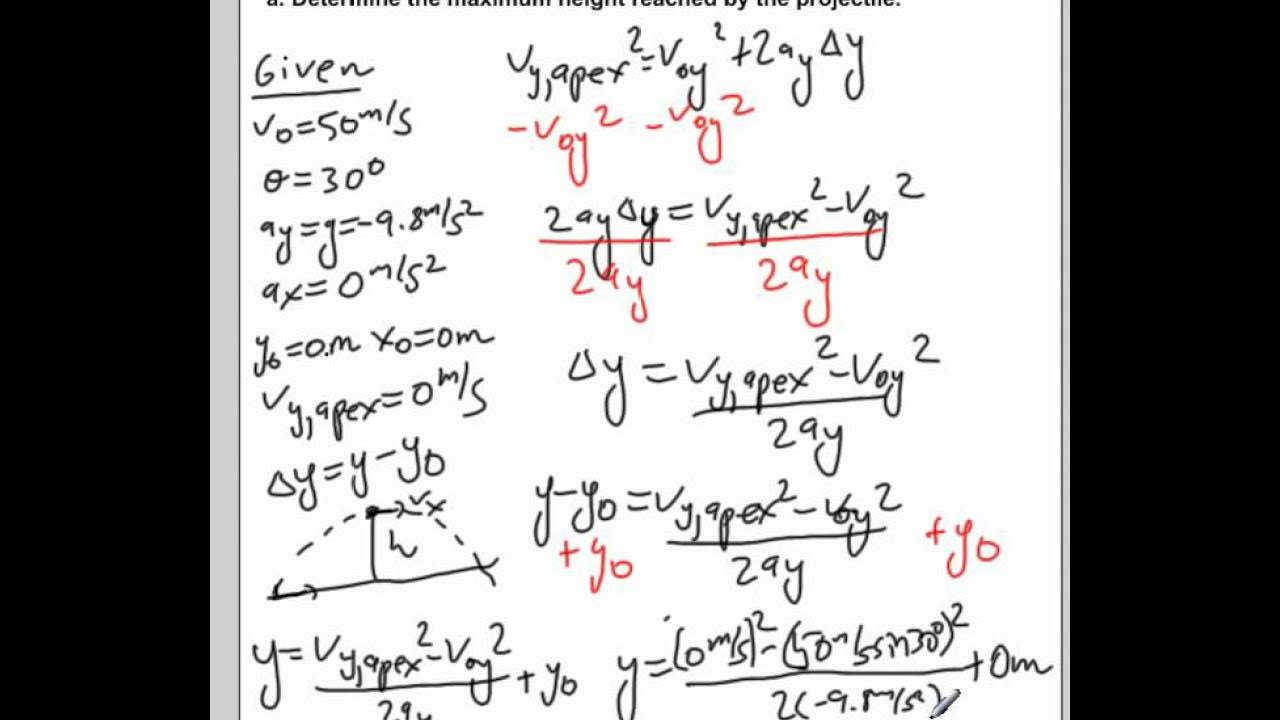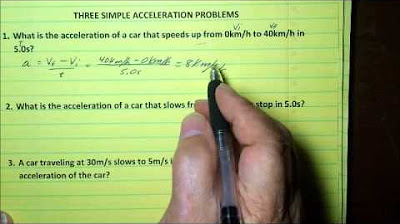AP Physics B Kinematics Presentation #03
TLDRThis tutorial explains how to calculate the time it takes for an object to come to rest given its initial velocity and acceleration. The instructor identifies key information: initial velocity (5 m/s), acceleration (-2 m/s²), and final velocity (0 m/s). Using the kinematic equation v = v_0 + at, they solve for time (t). After rearranging the equation and substituting the values, the instructor calculates the time to be 2.5 seconds. Emphasis is placed on ensuring the final time value is positive, as time is a scalar quantity.
Takeaways
- ✏️ The initial velocity (V_initial) is 5 m/s.
- ⏱️ The final velocity (V_final) is 0 m/s (object comes to rest).
- 📉 The acceleration (a) is -2 m/s².
- ❓ We need to find the time (T) it takes for the object to come to rest.
- 📝 Write down the given information first: V_initial = 5 m/s, V_final = 0 m/s, a = -2 m/s².
- 📐 Use the kinematic equation V_final = V_initial + a * T.
- 🔄 Rearrange the equation to solve for T: T = (V_final - V_initial) / a.
- 🧮 Plug in the given values: T = (0 - 5) / -2.
- 🕒 Calculate the time: T = 2.5 seconds.
- ✅ Time must be a positive value because it is a scalar, not a vector.
Q & A
What is the initial velocity given in the problem?
-The initial velocity is 5 m/s.
What is the acceleration provided in the problem?
-The acceleration is -2 m/s².
What is the final velocity of the object when it comes to rest?
-The final velocity is 0 m/s.
What kinematic equation is used to solve for the time?
-The kinematic equation used is v = v₀ + at.
Why are the other two kinematic equations not used in this problem?
-The other two kinematic equations are not used because they depend on position, which is not provided in the problem.
What algebraic steps are taken to solve the kinematic equation for time (t)?
-First, subtract v₀ from both sides to get at = v - v₀. Then, divide both sides by a to solve for t: t = (v - v₀) / a.
What are the values plugged into the equation to solve for time?
-The values plugged in are: final velocity (v) = 0 m/s, initial velocity (v₀) = 5 m/s, and acceleration (a) = -2 m/s².
What is the calculated time for the object to come to rest?
-The calculated time is 2.5 seconds.
Why is it important to ensure the time calculated is positive?
-Time is a scalar quantity and cannot be negative, as it does not depend on direction.
What should you do if you end up with a negative time value?
-You should check your calculations to ensure you did not lose a negative sign somewhere in the process.
Outlines
🕒 Calculating Time to Come to Rest
This paragraph explains the process of solving a physics problem where an object comes to rest. The given information includes an initial velocity of 5 m/s and an acceleration of -2 m/s². The goal is to find the time it takes for the object to come to rest. Key steps include identifying the final velocity (0 m/s), the initial velocity (5 m/s), and the acceleration (-2 m/s²). The relevant kinematic equation used is \( v = v_0 + at \). The paragraph describes rearranging the equation to solve for time (t) and plugging in the given values, resulting in a calculated time of 2.5 seconds. It also emphasizes the importance of keeping track of negative signs and ensuring the time result is positive, as time is a scalar quantity.
Mindmap
Keywords
💡Initial velocity
💡Acceleration
💡Final velocity
💡Time
💡Kinematic equations
💡Algebra
💡Negative sign
💡Scalar
💡Rest
💡Units
Highlights
First step for solving the problem is to write down the given information.
Determine the final velocity, which is 0 m/s since the object comes to rest.
Initial velocity is given as 5 m/s.
Acceleration is given as -2 m/s².
The problem asks for the time it takes to come to rest, so we need to solve for time (T).
Identify the relevant kinematic equations.
Choose the equation v = v₀ + at since it does not involve position.
Rearrange the equation to solve for time (T).
Subtract the initial velocity from both sides: at = v - v₀.
Divide both sides by acceleration (a): T = (v - v₀) / a.
Plug in the given values: final velocity (v) = 0 m/s, initial velocity (v₀) = 5 m/s, and acceleration (a) = -2 m/s².
Calculate the time: T = (0 - 5) / -2.
The result is T = 2.5 seconds.
Ensure the final time value is positive, as time is a scalar quantity.
Reminder: Time cannot be negative, so always check for correct sign usage.
Transcripts
5.0 / 5 (0 votes)
Thanks for rating:





